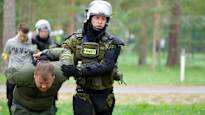The newly established emergency preparedness unit is to be increased to a thousand reservists in the next few years. The members of the unit have a military police background.
NURSIPALU – “Come here, and we’ll measure the man”, a young man shouts in English from behind the green metal fence.
At the same time, his friends dig a hole under the fence with a shovel. There is a group of ten people coming through the fence.
On the other side of the fence is the emergency response unit of the Estonian Police and Border Agency. An operational exercise is underway at the Nursipalu training area of the Defense Forces.
According to the script of the exercise, 10,000 migrants have been gathered behind Estonia’s eastern border. They start to try to cross the border in larger and larger groups.
A few hundred meters away, a much larger group of intruders attack a large gate. A water cannon fires and a loud high-pitched sound is played in the direction of the attackers.
– It is obvious that the resources of the police and border agency are not enough to handle such large events, but we need more helping hands, says the director general of the agency following the exercise Egert Belichev To .
The order applies in a crisis situation, otherwise we are in civilian work
In 2010, the Estonian Border Guard was merged with the then established Police and Border Agency. Therefore, Estonia no longer has a military border guard nor a reserve that has completed conscript service.
The members of the new standby unit are reserve military police officers. It is an exceptional cooperation in Estonian conditions, when reservists of the Defense Forces are permanently put at the disposal of the Police and Border Agency.
The emergency unit is ordered to operate only in crisis situations. At other times, the members of the unit are normally at their peacetime work.
In Estonia, the term “ränderünne” or migration attack is used for the instrumentalized immigration organized by Russia and Belarus.
So far, Estonia has avoided significant mechanized imports. However, according to Belichev, it is not excluded that instrumentalized migration will also be targeted at Estonia.
– It is very likely.
The recently established emergency unit training in Nursipalu is the answer to these challenges, says Belitšev.
– The purpose is that in the future we would have a crisis time reserve of at least a thousand people, who could come to our aid if needed.
According to Belichev, the Police and Border Agency may need a reserve not only for the border but also for combating unrest or terrorism on the territory of Estonia.
The “drone wall” going up on the eastern border
In the next few years, Estonia will invest in border security in ways other than a new standby unit.
During the next three years, 100 million euros should be invested in border security, the Minister of the Interior and the chairman of the Social Democratic Party Lauri Läänemets tells in Nursipalu.
– It would go to the border infrastructure, the drone wall, the emergency unit, armaments and training.
The drone wall practically means a system for combating drones. It would also be able to detect low-flying drones and destroy them after a border violation.
Lääne forests discussed the drone wall initiative With the interior ministers of the Baltic countries, Poland, Finland and Norway in May in Latvia.
The Minister of the Interior admits that 100 million is a lot of money. Estonia has just invested approximately the same amount in fencing the eastern border and the state budget is badly in deficit.
– However, the situation calls for such decisions, Läänemets states.
According to Egert Beličev, the Police and Border Agency has strengthened its preparedness for years. A sufficient amount of equipment is stored.
Near-future acquisitions include new water cannons and armored vehicles.
– We must also be able to face armed attacks, says Belichev.
Estonia has decided to fence its entire 136-kilometer land border against Russia. At the end of last year, half of the planned barrier was ready.
For an actual war situation, Estonia has decided to fortify its eastern border. Bunkers that can accommodate 600 infantry teams will be built on the border in the next few years. Anti-tank mines, barriers and barrier wire are stored near the border.
What thoughts does Estonia’s preparation evoke? The subject can be discussed on 16.9. until 11 p.m.
